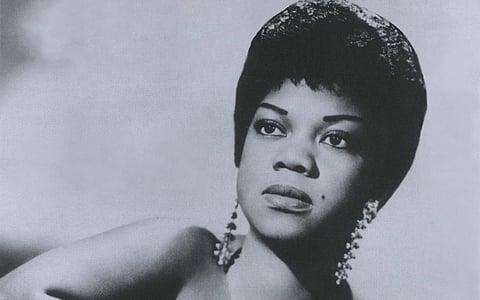All That Jazz: The Life and Legacy of Ernestine Anderson
by Kathya Alexander
Ernestine Anderson was just 16 years old when she announced to her parents that she was going to leave Seattle and go on the road to sing with a big band. She'd only recently moved to the city from Texas and was attending Garfield High School. Two years later, when the Johnny Otis band came to town, she made good on her promise, leaving Seattle in 1946 to eventually live in New York, Switzerland, and other cities throughout Europe during an illustrious six-decade career, during which she recorded more than 30 albums. But, no matter where she lived, her heart always pulled her back to her family and the city she loved.
Seattle's Central District in the 1940s and '50s was a jazz mecca. Fellow Garfield High School alum, Quincy Jones, described it as "screaming around the clock." Both Anderson and Jones performed with Garfield's jazz band and in various clubs on Seattle's Jackson Street. Music journalist Paul De Barros' book, Jackson Street After Hours: The Roots of Jazz in Seattle, has become the standard historical text on the Central District of Seattle and the jazz scene that was going on during the 1940s through the early '60s. But Anderson felt she needed to make it elsewhere before she would be recognized professionally at home.
"There were a lot of clubs in the Central area of Seattle: The Black and Tan, The Rocking Chair, and a whole bunch of other[s]," said Eugenie Jones, jazz singer and coproducer of "Celebrating Ernestine Anderson," a series of community events being held this month to honor the life and legacy of this incredible Seattle icon, who died in 2016.
Anderson did, eventually, achieve the home town recognition she craved as a jazz musician. In addition to her four Grammy nominations, and performances at Carnegie Hall and the Kennedy Center, she won the Golden Umbrella Award at the Bumbershoot Arts Festival in 2002, which honors artists from the Northwest "who have significantly contributed to the cultural landscape of our region." She was also chosen for the 2004 IMPACT Award by the Pacific Northwest Chapter of the Recording Academy, which honors Northwest music professionals "whose creative talents and accomplishments have crossed all musical boundaries and who have been recognized as an asset to the music community." A portion of Jackson Street also bears her name, and in 2012, the Low Income Housing Institute named a Central District housing complex "Ernestine Anderson Place" in her honor.
"Celebrating Ernestine Anderson" officially began on Nov. 2, with Eugenie Jones moderating a panel discussion on "The Life & Legacy of Ernestine Anderson" at Langston Hughes Performing Arts Institute. Jones chose people for the panel who had a personal relationship with Anderson: film producer and director Kay D. Ray, jazz DJ and producer Jim Wilke, and journalist Paul De Barros. Ray's documentary on Anderson, There Will Never Be Another You, was shown in its entirety at the event.
A City of Seattle Proclamation declaring Nov. 11 (Anderson's birthday) as Ernestine Anderson Day was read by Mayor Jenny Durkan. On Nov. 8, Jones presented a special school assembly for Garfield High students via webinar, exploring the life and legacy of the former alum. Due to COVID-19 restrictions, this event was only open to students.
Shelly Young, Anderson's daughter, was instrumental as a consultant over the course of planning the series, which will culminate Nov. 13 with the "Ernestine Anderson Musical Tribute" at Langston Performing Arts Institute, a live in-person evening of music, historic reflection, and entertainment featuring a star-studded lineup, including Jones; former legendary Crusaders band member Stix Hooper; jazz vocalist Gail Pettis; jazz musicians Pete Adams, Jamael Nance, and Medearis Dixson; bassist Paul Gabrielson; and more. Two honorees for the youth vocal competition, an 11-year-old and 14-year-old, will also perform.
In addition to music, a discussion between Stephanie Johnson-Toliver, president of the Black Heritage Society of Washington State, and John Gilbreath, executive director at Earshot Jazz, will offer the audience stories about Anderson's history. The Black Heritage Society owns the largest public archive of memorabilia documenting the lives and legacies of African Americans throughout the state. Johnson-Toliver will talk about Anderson's life and career and share photographs from their archives.
Jones is pleased that the tribute is led by the African American community and that proceeds from the event will go to Anderson's favorite charity, the Rotary Boys and Girls Club in the Central District. She said, "There are a number of organizations in Seattle that are focused on the legacy of African Americans and the African American community. And I encourage people to get involved, volunteer, become a donor, volunteer your time, and use the talents that God gave you to be a blessing to other people." How better to honor Anderson's legacy.
The Nov. 13 event follows King County's mandate that people ages 12 and older show proof of full COVID-19 vaccination or a negative test result within the last 72 hours for admission.
Kathya Alexander is a writer, actor, storyteller, and teaching artist. Her writing has appeared in various publications like ColorsNW Magazine and Arkana Magazine. She has won multiple awards including the Jack Straw Artist Support Program Award. Her collection of short stories, Angel In The Outhouse, is available on Amazon.
Featured Image: Ernestine Anderson. Photo courtesy of the Anderson family.
Before you move on to the next story …
The South Seattle Emerald™ is brought to you by Rainmakers. Rainmakers give recurring gifts at any amount. With around 1,000 Rainmakers, the Emerald™ is truly community-driven local media. Help us keep BIPOC-led media free and accessible.
If just half of our readers signed up to give $6 a month, we wouldn't have to fundraise for the rest of the year. Small amounts make a difference.
We cannot do this work without you. Become a Rainmaker today!
Help keep BIPOC-led, community-powered journalism free — become a Rainmaker today.


